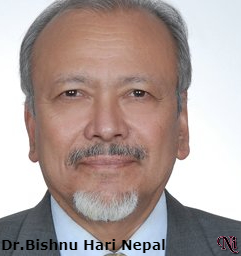On the Occasion of Pakistan Day March 23, 2022
Dr. Bishnu Hari Nepal
Former Ambassador of Nepal to Japan
Hon. Country Director, South Asia Policy Analysis Network SAPANA-Nepal
Even though Nepal and Pakistan established their official diplomatic relations on 20 March 1960, but the people to people ties, as part of the “Himalayan Civilization”, are linked since time immemorial.
Before the West recorded history of the Buddhist inscriptions in Mohenjo-daro and more, as part of the Indus Valley Civilization, in today’s Taxila (25km N-W from Islamabad) of Pakistan, the world’s first university, the Takshashila University, as the centre for learning in South Asia, existed.
Taxila is Urdu name. In Pali, it is known as Takkila and Sanskrit, Takshashila.
As per oriental philosophy, and as the part of the pre-historic civilizations in the Himalayas, the largest book on earth, even as of today (with 100,000 epics), the Mahabharata was written in Vedvyas Ashram, in today’s Tanahun district of Nepal.
But the Mahabharata for the first time was recited in Taxila in the presence of the writer Maharshi Vedvyas during the Sarpa Satra / Nagasuya Yagya –a ritual- by the then King Janamejaya.
He was the Grandson of Abhimannyu and son of Parikshit.
It shows the people to people link between the two countries since time immemorial.
This is the only one rarely explored part of the annals of the time immemorial relations followed by the Indus Valley Civilizations and more as ascribed by the Western Historians between the peoples of today’s Federal Democratic Republic of Nepal and the Islamic Republic of Pakistan.
While observing the modern evolutionary diplomatic endeavors, after the establishment of the official diplomatic relations in 1960, it is found that both countries kept their ties on high priority.
It’s because both countries were able to establish the residential embassies at the Ambassadorial level in their respective capitals in 1962.
By 1963, both countries were able to sign Most Favored Nation (MFN) protocol of bilateral relations.
As a result, both countries agreed to Free Trade Access and Transport Facilities through Port of Chittagong (Former East Pakistan), and also Air Link then.
During Indo-Pakistan War in East Pakistan, in 1971, Nepal took a non-aligned role considering good relations between both the warring countries.
But during the time of recognition of the newly created country Bangladesh by Nepal, Pakistan showed some displeasure with Nepal but it did not last long to understand the regional scenario to Pakistan, and the relations became as smooth as earlier.
It’s because with the main rival India, Pakistan had signed the Shimla Agreement in 1972. As a result, in 1975, Nepalese Hon. Consulate General Office was established in Karachi. The step itself was another milestone in friendly relations between the two countries.
Nepal-Pakistan Relations at the Present Day Context:
There are so many cherished illustrations on bilateral, regional and international events that Nepal and Pakistan stand together in the modern diplomatic maneuvers.
I like to cite just five of them:
One: It’s very interesting that the British when they hired Gurkhas after the Anglo-Nepal-War, “War of Sugauli” (1814-1816), they trained the Gurkhas in the beautiful city of Lahore.
And back home in Nepal, the Gurkhas were/are popularly recognized as “Lahure”. In fact, the popular word Lahure was derived from the place where they were trained, i. e., from the beautiful city of Lahore!
Two: The Nepalese people will never forget Pakistan’s magnanimous support to Nepal, when Nepal suffered a national crisis due to the devastating EQ 2015, and Flood and Landslides 2017 ($1.00m) and the Line of Credit to Nepal of $ 5.00m and more.
Three: Unwritten history that late King Birendra had deleted his prepared speech -with the proposal of ZOP in the NAM Algiers Summit in 1973. But in his Coronation Banquet on 25 February 1975, he proudly put the ZOP proposal before the world leaders in Kathmandu.
Pakistan entirely understood Nepal’s position and firmly stood in support of Nepal’s ZOP proposal –which was the mainstream of the Nepalese Foreign Policy then indeed.
Four: Starting from the President level in 1963, the Prime Ministerial level visits from Pakistan to Nepal in 1994, 2014 and 2018 have always added one more brick in cementing the bilateral relations and demonstrated the proximity, common platform and cordial friendship as part of Pakistan and Nepal both playing a pro-active role with neighbors in South Asia.
In 2019, both countries celebrated 60-years of diplomatic ties and was a rejoicing moment indeed.
Five: The historic winter ascent of Pakistan’s Mt. K2 (8611m, 2nd highest in the world) by the 10-Nepali Mountaineers risking their lives on 16 January 2021, Saturday is a profound example of true friendship between the people and the countries bilaterally.
Measuring Nepal-Pakistan Relations thru’ “4T-HEI Model” (Nepal, 2003/2018):

On T1 = Trade Paradigm: After 1962, MFN trade protocol, both countries signed Trade Agreements in 1982 also. Both countries are committed to SAFTA and South Asian Economic Union-SAEU.
Total volume of trade between the two countries stands to be around US$ 4.8m.
Pakistan exports goods worth of $1.631m to Nepal and Nepal exports goods worth of $3.166m around.
The Joint Business Council (JBC) formed in 1996 and composed of Federation of Nepal Chamber of Commerce and Industry-FNCCI and Federation Pakistan Chamber of Commerce FPCCI need to work hard further to increase the volume of trade indeed.
Similarly, in 2005, the research shows that Confederation of Nepalese Industries-CNI made agreements with Karachi, Islamabad and Lahore Chambers of Commerce and Industries.
In retrospect, as mentioned above, both countries started Trade Agreement as early as 19 October 1962. It read, the Trade Agreement “… provides for a grant of the ‘most favored nation’ treatment by the one country to the other in matters of commerce.” (Y.P. Pant, 1962)
They were renewed in 1982, 1984, 2018 etc. but the most important today is that like the Foreign Secretary level Bilateral Consultation Mechanism, the Finance Ministerial Level JEC-Joint Economic Commission also need to be reactivated so that it can recommend the more effective prognosis to increase the trade volume of identified and unidentified goods.
On T2= Tourism sector, both countries had an important agreement in 2009. Today, nearly 5000 Pak tourists visit to Nepal every year but it invites more efforts to increase the number bilaterally in the days to come.
T3: Transportation: There is an urgent need that more airlines start flights between Kathmandu and bigger cities of Pakistan.
Nepal could Join Karakorum Highway through BRI via Kerung (at the moment).
The most economic route will be via Him Canal (Nepal, 2003/2004/2011/2018), if implemented, joining -21st Century Maritime Silk Road (Route) in Bay of Bengal and via Sri Lanka, Maldives and Gwadar joining CPEC.
T4: Transfer of Technology: It is encouraging that Pakistan has increased scholarship quotas for Nepal also in 2018 through PTAP-Pakistan Technical Assistance Program -number of students reaching more than 500.
Hence the Transfer of Technology can be implemented to Human Resources Management, Agricultural Development, Social Development (1970, both countries signed Cultural Agreement: Inter-universities and communications and established Nepal-Pakistan Friendship & Cultural Association at Kathmandu and the NFG-Nepal Friendship Group in Islamabad), Infrastructure Development, Energy and Environment conservation areas, etc.
HEI: Hydropower/Energy, Environment and Investment Promotion:
Nepal can sincerely learn in Hydro Generation that Pakistan is not only utilizing China Pakistan Economic Corridor (CPEC) in connectivity & infrastructure development but also producing Hydro more than 23,000MW indeed. It’s tremendously helping Environment Conservation too.
On FDI, Nepal could learn from Pakistan that it is utilizing nearly $65bn from CPEC under BRI and AIIB alone.
China’s promise of $16.3bn investment in Nepal through BRI is a big money for Nepal but the pace of development is not getting the momentum as anticipated.
Summation:
This is an open secret that the detrimental effects of the Indo-Pak conflicts have threatened the effectiveness of SAARC.
Pakistan was prepared to hold the scheduled 19th SAARC Summit on 15-16 November 2016 but due to India’s unwillingness, mainly, it could not be realized until today. Nepal’s efforts as Chair of the SAARC body playing crucial role to normalize the situation and hold the SAARC Summit in Islamabad were praiseworthy, and are still continuing.
As a matter of fact, as per SAARC protocol, Pakistan is the de jure President after Nepal.
But the diplomatic procedures are taking shapes in a different paradigm shifts.
On Track II Diplomacy level also, we are working hard to bring South Asia on track.
Theoretically, through my “Reaching the Unreachable Model”, I personally have made thousands of comments for the contemporary South Asian Order System.
It’s certainly difficult to resolve the South Asian stratification by making a homogeneous SAARC body, but it is not impossible.
At hand, the survival of SAARC even in cementing Nepal-Pakistan Relations is inevitable and significant in the regional perspective.
(The distinguished Author is a Global Critic on International Relations, Peace, Conflict, Security and Development Studies and is available at: http://www.twitter.com/drbishnuhnepal).
Our contact address is: editor.telegraphnepal@gmail.com

